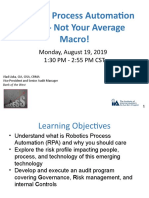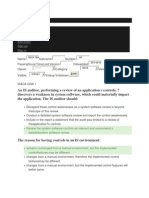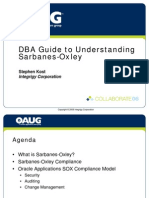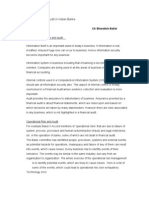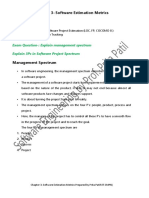Risks in An RPA Environment: Phases of Audit Considerations
Risks in An RPA Environment: Phases of Audit Considerations
Uploaded by
Vikram ThoratCopyright:
Available Formats
Risks in An RPA Environment: Phases of Audit Considerations
Risks in An RPA Environment: Phases of Audit Considerations
Uploaded by
Vikram ThoratOriginal Title
Copyright
Available Formats
Share this document
Did you find this document useful?
Is this content inappropriate?
Copyright:
Available Formats
Risks in An RPA Environment: Phases of Audit Considerations
Risks in An RPA Environment: Phases of Audit Considerations
Uploaded by
Vikram ThoratCopyright:
Available Formats
Risks in an RPA environment
RPA brings its own inherent risks as well the ones that are resultant of the business environment it automates. As part of RPA
assurance, we can address following access security risks:
• Automation of process through RPA without embedding/aligning control design may lead to manual override or
unauthorized changes which often goes undetected.
• Generic BOT ID often poses risk of non compliance to software licenses due to potential indirect usage
• BOTs stores credentials of multiple applications, which are often empowered with extensive access. Unauthorized
access and use of BOT credentials may lead to data, security, privacy and fraud risks
Considerations at different phases of audit when auditing a BOT environment:
Phases of Audit Considerations
Planning: • Audit plans and risk assessment for RPA
• Detailed understanding of the areas • Update to control matrices for automation through RPA
where RPA is implemented • Upfront involvement of IS Auditor/BOT Specialists
• Audit Plans
Walkthrough: • New IS/IT risks and scoped in systems
• Understanding of the process & IT • Changes to automated controls, IPE/IUC , audit logs and interfaces
• Identification of Risks and Controls • More IS Risks and therefore enhanced ITGCC controls
Design Evaluation: • Substantial work by IS Auditor to test controls from Design
• Evaluation of the Design of controls (Configuration controls, logs, Cyber risks)
• Exception handling process • Testing for IPE/IUC
• Identification of gaps
Operating effectiveness: • Increased controls testing and minimal substantive testing
• Controls Testing • Process governance and roles
• Substantive Testing
Reporting: • Logs and audit trails
• Gaps reporting • Changes to control design, RCM, SOPs, roles etc.
• Recommendations • Technology recommendations
Control Areas in BOT Environment
A secured and compliant BOT environment requires effective management and monitoring of the seven risk domains. Depending on the
relevance, each of these domains would help strengthen security and controls in your RPA environment. The below framework presents
a clear view about the types of risk which need to be considered when auditing a BOT-enabled organization. The auditor should try to
use a risk based approach to identify the controls addressing each of the RPA-specific risk consideration. Every domain of general IT
controls such as user-access management, change management, operations, and program development is important to be looked at
for the relevant BOTs.
You might also like
- Software Implementation Audit Program OverviewDocument7 pagesSoftware Implementation Audit Program OverviewMayur PatelNo ratings yet
- Product Sheet - Diligent ACL AnalyticsDocument2 pagesProduct Sheet - Diligent ACL AnalyticsDaniel lewisNo ratings yet
- Auditing Information Systems: Enhancing Performance of the EnterpriseFrom EverandAuditing Information Systems: Enhancing Performance of the EnterpriseNo ratings yet
- Case 4 - Alternative Distribution StrategiesDocument8 pagesCase 4 - Alternative Distribution Strategiesmohamed mohamedgalalNo ratings yet
- Information Systems Auditing: The IS Audit Testing Process: Information Systems Auditing, #3From EverandInformation Systems Auditing: The IS Audit Testing Process: Information Systems Auditing, #3Rating: 1 out of 5 stars1/5 (1)
- Importance of Research in Social Work Pr-pages-DeletedDocument8 pagesImportance of Research in Social Work Pr-pages-DeletedAnirban GoswamiNo ratings yet
- Jalandhar Address For Sports GoodsDocument25 pagesJalandhar Address For Sports GoodsSimran SohwanNo ratings yet
- BSP Circular No. 808-13 Guidelines On Information Technology Risk ManagementDocument73 pagesBSP Circular No. 808-13 Guidelines On Information Technology Risk ManagementAlexandra Castro-SamsonNo ratings yet
- Sox GC Ac SpreadsheetcompressedDocument92 pagesSox GC Ac SpreadsheetcompressedSaugat BoseNo ratings yet
- 21 - WK 9 Slides IMPACT OF IT ON INTERNAL AUDITING AND RISK WEEK 9Document20 pages21 - WK 9 Slides IMPACT OF IT ON INTERNAL AUDITING AND RISK WEEK 9Camilo ToroNo ratings yet
- CH08Document42 pagesCH08Fachrurrozi100% (2)
- Module VI - Business Application Software Audit - EmailDocument91 pagesModule VI - Business Application Software Audit - EmailJYOTSNANo ratings yet
- Performing Vendor Security Risk AssessmentsDocument12 pagesPerforming Vendor Security Risk AssessmentsJohn Bertoli100% (3)
- Pertemuan 2 - Information System Risk and ControlDocument72 pagesPertemuan 2 - Information System Risk and ControlRey RaNo ratings yet
- Is Audit Report - Chapter 8Document14 pagesIs Audit Report - Chapter 8Mary Grace Caguioa AgasNo ratings yet
- PWC It Internal AuditDocument2 pagesPWC It Internal AuditcvcrasnierNo ratings yet
- Accounting Information Systems: Moscove, Simkin & BagranoffDocument37 pagesAccounting Information Systems: Moscove, Simkin & BagranoffDaiannaNo ratings yet
- Advanced Computer Auditing Notes 2024 - Topic 1&2 For ClassDocument68 pagesAdvanced Computer Auditing Notes 2024 - Topic 1&2 For ClassEverjoice ChatoraNo ratings yet
- IT Controls Part I: Sarbanes-Oxley & IT GovernanceDocument39 pagesIT Controls Part I: Sarbanes-Oxley & IT GovernanceToxy Kayz100% (1)
- How To Do A General IT ContrDocument46 pagesHow To Do A General IT ContrNicolas Astudillo100% (2)
- Robotics Process Automation (RPA)Document29 pagesRobotics Process Automation (RPA)Big B's ZoneNo ratings yet
- Oracle GRC OverviewDocument46 pagesOracle GRC OverviewSriram KalidossNo ratings yet
- Cisa Exam 1Document23 pagesCisa Exam 1Ashish Jaiswal100% (1)
- Audit Automation As The Foundation of Continuous AuditingDocument12 pagesAudit Automation As The Foundation of Continuous AuditingNhicoleChoiNo ratings yet
- DBA Guide To Understanding Sarbanes Oxley PresentationDocument25 pagesDBA Guide To Understanding Sarbanes Oxley PresentationrlfacanhaNo ratings yet
- Audit of IT Security 061cab1246c98f6 59791303Document42 pagesAudit of IT Security 061cab1246c98f6 59791303PRUTHVI SNo ratings yet
- Risk Based InspectionDocument0 pagesRisk Based Inspectionpersonalmail_20011078No ratings yet
- Ais Chapter 12Document20 pagesAis Chapter 12Clarissa A. FababairNo ratings yet
- Information System Audit in Indian BanksDocument8 pagesInformation System Audit in Indian BanksbballalNo ratings yet
- 1.ISAUD - Information Technology Risk and Controls PDFDocument28 pages1.ISAUD - Information Technology Risk and Controls PDFRabbani AzizNo ratings yet
- Rpa Sample ReportDocument11 pagesRpa Sample ReportPavan PrabhuNo ratings yet
- Cisa 2Document6 pagesCisa 2Ahmad MaaytahNo ratings yet
- Computer Auditing Lecture SlidesDocument54 pagesComputer Auditing Lecture Slidesqtf796kfqmNo ratings yet
- types auditDocument23 pagestypes auditmahadahmed3164No ratings yet
- Best Practices For User Access Controls and Segregation of DutiesDocument13 pagesBest Practices For User Access Controls and Segregation of DutiesLOkesh VErmaNo ratings yet
- Information Technology (IT) AuditDocument31 pagesInformation Technology (IT) AuditCharmaine ChuaNo ratings yet
- l6 - Verfication ValidationDocument30 pagesl6 - Verfication ValidationDeepak PatelNo ratings yet
- Application Sys. ReviewDocument4 pagesApplication Sys. ReviewadiltsaNo ratings yet
- Domain 6 - Security Assessment & TestingDocument20 pagesDomain 6 - Security Assessment & TestingLouie MokNo ratings yet
- RPA Sem PrepDocument36 pagesRPA Sem Prepthemanth109No ratings yet
- 10.2 Using CaattsDocument38 pages10.2 Using CaattsPauline MercadoNo ratings yet
- Advance Controls (Oracle GRC)Document8 pagesAdvance Controls (Oracle GRC)Seshagiri RaoNo ratings yet
- The Audit ProcessDocument21 pagesThe Audit ProcessMariale GBNo ratings yet
- Chapter 26 FinalDocument3 pagesChapter 26 FinalLenlen VersozaNo ratings yet
- AB AR Planning An Audit From ScratchDocument7 pagesAB AR Planning An Audit From ScratchJerad KotiNo ratings yet
- Auditing: Information Technology System EnvironmentDocument45 pagesAuditing: Information Technology System EnvironmentRENATO CAPUNONo ratings yet
- Lesson 1 Overview of IT AuditDocument42 pagesLesson 1 Overview of IT AuditMCDABCNo ratings yet
- Ac220 - CaatsDocument17 pagesAc220 - CaatsChristineNo ratings yet
- Rpa SecurityDocument4 pagesRpa Securitychirag suresh chiruNo ratings yet
- Chapter 5 AudcisDocument32 pagesChapter 5 AudcisSassy GirlNo ratings yet
- Internal Control and Is AuditDocument24 pagesInternal Control and Is AuditPinta Saras Puspita100% (1)
- What Is An Internal Control?Document6 pagesWhat Is An Internal Control?Akhil KotianNo ratings yet
- Access ControlsDocument11 pagesAccess ControlsadiltsaNo ratings yet
- Audit It 250759Document32 pagesAudit It 250759Dragan StojanovicNo ratings yet
- 3.software Quality AssuranceDocument22 pages3.software Quality AssurancearunlaldsNo ratings yet
- Chapter 16 Auditing in CIS EnvironmentDocument22 pagesChapter 16 Auditing in CIS EnvironmentMoksha HunterNo ratings yet
- IT and Financial Compliance: Closing The Gaps in Sarbanes-Oxley April 19, 2005 Steve Greenstein / Rudy KisteDocument24 pagesIT and Financial Compliance: Closing The Gaps in Sarbanes-Oxley April 19, 2005 Steve Greenstein / Rudy KisteTanya GrewalNo ratings yet
- Lecture 3Document20 pagesLecture 3Ebisa AjemaNo ratings yet
- Chapter 3 Software Estimation MetricsDocument32 pagesChapter 3 Software Estimation MetricsAshmeet AroraNo ratings yet
- Module-2 Notes Updated CompressedDocument28 pagesModule-2 Notes Updated CompressedKaushik Prabhu-NerurkarNo ratings yet
- Introduction To RPADocument11 pagesIntroduction To RPAVince Espinosa100% (1)
- CISA - 3th Chapter - System and SDLCDocument12 pagesCISA - 3th Chapter - System and SDLCfaizthemeNo ratings yet
- Information Systems Auditing: The IS Audit Study and Evaluation of Controls Process: Information Systems Auditing, #2From EverandInformation Systems Auditing: The IS Audit Study and Evaluation of Controls Process: Information Systems Auditing, #2Rating: 3 out of 5 stars3/5 (2)
- Certified Information Systems Auditor Exam Prep And Dumps Exam Review Guide for ISACA CISA Exam PART 1From EverandCertified Information Systems Auditor Exam Prep And Dumps Exam Review Guide for ISACA CISA Exam PART 1No ratings yet
- Cot Lesson Plan June 2021Document3 pagesCot Lesson Plan June 2021Nette NetteNo ratings yet
- Coworking Space in Hyderabad - Premium Coworking Spaces in Hyderabad PDFDocument4 pagesCoworking Space in Hyderabad - Premium Coworking Spaces in Hyderabad PDFisprout marketingNo ratings yet
- This Study Resource WasDocument1 pageThis Study Resource WasAlipaspas, Jill AnneNo ratings yet
- PACKAGEOLOGYDocument31 pagesPACKAGEOLOGYPearl Margarette ManaigNo ratings yet
- Freedom of Expression in Malaysia 2010Document78 pagesFreedom of Expression in Malaysia 2010Walski of Sound100% (1)
- LESSON 1.2 Gov and Governce NOTES PDFDocument2 pagesLESSON 1.2 Gov and Governce NOTES PDFkimberson alacyangNo ratings yet
- Department of Business Administration, Sambalpur University, Jyoti Vihar, 768019, OdishaDocument2 pagesDepartment of Business Administration, Sambalpur University, Jyoti Vihar, 768019, OdishaNamrata MishraNo ratings yet
- Data Privacy Act of 2012Document35 pagesData Privacy Act of 2012Cordelia Marisse ReyesNo ratings yet
- C THR86 1711 Exam Guide and How To CrackDocument5 pagesC THR86 1711 Exam Guide and How To CrackPraveen BNo ratings yet
- Mental Health Crisis Intervention ResourcesDocument4 pagesMental Health Crisis Intervention ResourcesgggNo ratings yet
- Understanding Culture, Society, and Politics: Grade 11/12 Significance of Cultural Symbols and PracticesDocument28 pagesUnderstanding Culture, Society, and Politics: Grade 11/12 Significance of Cultural Symbols and PracticesPot Alo50% (2)
- Tryout Bahasa Inggris PPPK Ke5Document76 pagesTryout Bahasa Inggris PPPK Ke5Ririn AsriyantiNo ratings yet
- Republic of The Philippines Puerto Princesa City: DC GeneratorsDocument3 pagesRepublic of The Philippines Puerto Princesa City: DC GeneratorsMiko F. RodriguezNo ratings yet
- Prefabricated MFOBDocument86 pagesPrefabricated MFOBovikbasuNo ratings yet
- AG Nominee Loretta Lynch Discusses The Death PenaltyDocument24 pagesAG Nominee Loretta Lynch Discusses The Death PenaltyGotNewsNo ratings yet
- 400 Largest Printers 2020Document17 pages400 Largest Printers 2020Bob DowlingNo ratings yet
- 001 VALLE Samahan NG Manggagawa V BLRDocument4 pages001 VALLE Samahan NG Manggagawa V BLRDaniel Danjur DagumanNo ratings yet
- F35 JSFDocument8 pagesF35 JSFV2100% (1)
- Welcome Bienvenue: International Programs Student HandbookDocument14 pagesWelcome Bienvenue: International Programs Student HandbookLuis carmonaNo ratings yet
- Labor Standards Outline (2020)Document19 pagesLabor Standards Outline (2020)Kyle Dionisio100% (1)
- Manajemen Konflik Dalam-PeningkatanDocument12 pagesManajemen Konflik Dalam-Peningkatansity khoeriahNo ratings yet
- Empowerment Empowerment EmpowermentDocument27 pagesEmpowerment Empowerment EmpowermentVIRGILIO JR FABINo ratings yet
- Mathematics in Our WorldDocument7 pagesMathematics in Our WorldChicos tacosNo ratings yet
- Kayah Loikaw enDocument58 pagesKayah Loikaw enwannamoreNo ratings yet
- 1 Supply Chain Management Overview of Supply Chains Management 2 HoursDocument18 pages1 Supply Chain Management Overview of Supply Chains Management 2 HoursRv TejadaNo ratings yet
- People Vs HindoyDocument2 pagesPeople Vs HindoyMhay Khaeyl Badajos AndohuYhanNo ratings yet




















